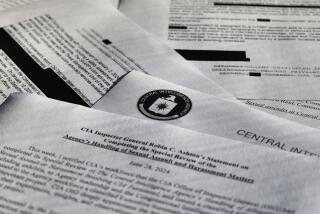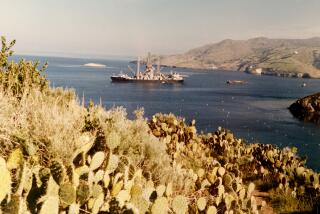No Letup in Search for ‘the 4th Man’
- Share via
WASHINGTON — Amid the clamor of the hunt for Saddam Hussein and Osama bin Laden, another, much older, quieter and equally daunting manhunt grinds on. A dozen years after the final curtain was drawn on the Soviet Union, American spy hunters continue to sift the ashes of espionage operations gone cold in the 1980s, searching for clues that might lead them to “the fourth man” -- to what, it is hoped, will be the final traitor in a quartet of Americans who betrayed so many of our spies in Moscow during the Cold War.
It started in 1985, the Year of the Spy. The FBI and CIA began suffering catastrophic losses of Soviet agents in Moscow who had taken the near-suicidal risk of changing camps and working with U.S. intelligence. One by one, they were apprehended, tried and marched along a darkened basement corridor in one of Moscow’s “shooting prisons” until, at some much-feared and never fully unexpected moment, a KGB executioner would step silently out of a dark cranny and fire a bullet into the back of the condemned man’s brain.
There were 10 of them, and with each died a complex set of dreams, a mixture of personal hopes and visions for Mother Russia. Even more complex was the mix of human motivations that prompted these men to engage in the riskiest undertaking for any Soviet citizen of that era. In the wilderness of mirrors that was then the KGB-CIA counterintelligence standoff, these human losses became known as “the 1985 problem.”
I entered that wilderness in the summer of 1985, just as the CIA was sounding the counterintelligence equivalent of “general quarters” in Moscow. As the new No. 2 in the agency’s Soviet East European Division, I was drawn into the vortex of this espionage maelstrom and became caught up in innovative but ultimately failed attempts to flush out our betrayers. We drew ever-tightening concentric circles of protection around our remaining spies in Moscow, but nothing seemed to protect them from compromise and arrest.
Even when we discovered the first traitor in our midst, the strange relief brought by the awful discovery was short-lived.
In 1985, Edward Lee Howard, a former CIA officer who had been on a track for a Moscow assignment when he was fired by the agency, was fingered by KGB defector Vitaly Yurchenko as a revenge-driven turncoat. Yurchenko cataloged the CIA operations that Howard had sold to Moscow. Forewarned, Howard made a daring escape from FBI surveillance, ending up in Moscow and the sanctuary of the KGB.
The instant assessment of Howard’s treachery was that it explained the loss of a few of the men in Moscow, but not all. Operations that Howard could not have known about were rolled up by the KGB in the same elaborate style as the operations of those he had betrayed, a sure sign the KGB was going to great ends to protect its source or sources inside U.S. intelligence. To be sure, Howard was part of the problem, but not the end of it.
In fairly short order, another possible solution to the 1985 riddle presented itself. In 1987, two Marine guards at our embassy in Moscow were implicated in a KGB operation against the CIA. It seemed to some at CIA headquarters that the other shoe had dropped. But it hadn’t. Neither man proved to be the missing link to our troubles, and we were back to square one.
As the Soviet Union began to wobble in the late 1980s, the search for the traitor at the CIA lost momentum. The 1985 problems seemed all but forgotten as the Berlin Wall fell in 1989 and the Warsaw Pact and the Soviet Union disintegrated a few years later. But even against the stunning backdrop of the collapse of America’s main enemy, a handful of men and women in Langley, Va., doggedly continued the search for answers. In February 1994, CIA officer Aldrich H. Ames was arrested for treason.
As soon as he was arrested, however, it became clear to his interrogators that Ames alone could not explain the remaining mysteries of the 1985 losses. So the search went on for almost another seven years, until FBI Agent Robert Philip Hanssen was identified as Moscow’s man, bringing to three the number of Americans known to be part of the 1985 problem.
But doubts lingered. It soon became obvious to the mole hunters that there had to be another traitor, someone still out there, still living with his treachery. Much like the search for Britain’s infamous “Cambridge Five,” an investigation that spanned four decades, America’s Cold War legacy of spies and the pursuit of the fourth man who betrayed and killed those he was sworn to protect will go on.
Half a world away in Moscow, a parallel hunt for spies endures. I recently found myself sitting across a table from Moscow’s chief spy hunter, Aleksandr “Sasha” Zhomov, the man who knows deep in his gut that Ames was not caught by analysis -- as claimed by U.S. counterintelligence -- but was betrayed by someone inside the Russian Federal Security Service, the FSB. Zhomov is committed to tracking down the man who betrayed Ames, and has vowed to stay on the job until he has his quarry in shackles in Lefortovo Prison.
The Russian mole hunter’s search was broadened in 2001 following the arrest of Hanssen. I can still see Zhomov’s steel-gray eyes darken as we sat across from each other in Moscow, the Russian counterintelligence officer fingering a delicate silver crucifix on a chain around his neck and promising me that he would not rest until he had found the traitors in his midst.
After nearly half a century of intelligence battles between the CIA and the KGB, it is difficult to tell the victors from the vanquished. In his book on the back-alley battles, retired KGB Maj. Gen. Oleg Kalugin declared that at the end of the Cold War, the KGB’s “decades-long struggle with the CIA had turned into a rout,” that “the KGB’s foreign operations had been collapsing for years as a result of ceaseless defections and ensuing exposure of Soviet agents working abroad. It was like rats leaving a sinking ship.”
With at least some of the rest of the story now known, it has become clear that the final battle between the KGB and the CIA was no rout at all. It was a pretty even match, something closer to the bludgeoning of the 1975 Ali- Frazier fight in Manila, with both contestants beaten almost senseless.
More to Read
Sign up for Essential California
The most important California stories and recommendations in your inbox every morning.
You may occasionally receive promotional content from the Los Angeles Times.










